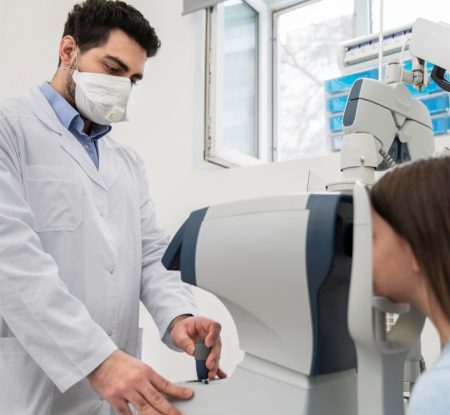

What is Cataract or Motibindu
A cataract is a cloudy area in the lens of your eye (the clear structure inside the eye that helps to focus light). Cataract are generally seen in older patients.At first, you may not experience any visual complaints if the cataract is in early stages. But over time, cataract can make your vision blurry, hazy, or less colorful. You may have trouble reading or doing other everyday activities.
Over time, cataract can lead to vision loss.
The good news is that surgery can get rid of cataract. Cataract surgery is safe and corrects vision problems caused by cataract.
What are the types of cataract?
No matter what type of cataract you have, you’ll need surgery to treat it.
What’s the treatment for cataract?
A new prescription for eyeglasses or contact lenses can help you see better with cataract early on. But,Surgery is the only way to get rid of a cataract Surgery. Your doctor might suggest surgery if your cataract start getting in the way of everyday activities like reading, driving, or watching TV. During cataract surgery, the doctor removes the clouded lens and replaces it with a new, artificial lens (also called an intraocular lens, or IOL).
Who needs cataract surgery?
Your eye doctor will probably suggest cataract surgery if you have Low vision that gets in the way of everyday activities like reading, driving, or watching TV.
Your doctor might also recommend surgery even if your cataract aren’t the main cause of your vision problems. For example, you may need to have cataract removed so your doctor can see into the back of your eye. This can help them track and treat other eye conditions, like diabetic retinopathy or age-related macular degeneration (AMD).
Keep in mind that if you have cataract in both eyes, you’ll need to have surgery on each eye.
We're
Expert
What are the different types of cataract surgery?
Robotic Femtosecond Laser Assisted Cataract Surgery
Premium - Micro incision Cataract surgery
Phacoemul-
sification Cataract surgery
Small incision Cataract surgery

CATARACT
You Can Find All Answers Here
You might not have any symptoms at first, when cataract are mild. But as it grows, it can cause changes in your vision. For example, you may notice that:
• You see halos and glares around light
• Double vision
• You can’t see well at night
• Lamps, sunlight, or headlights seem too bright
• You see double (this sometimes goes away as the cataract gets matured)
• You have to change the prescription for your glasses or contact lenses often
Your risk for cataract goes up as you get older. You’re also at higher risk if you:
- Have certain health problems, like diabetes & Hypertension(B.P.)
- Chronic Smoking
- Heavy alcohol intake
- Family history of Cataract
- Have had an eye injury, eye surgery, or radiation treatment on your upper body
- Have spent a lot of time in the sun
- Steroid intake — medicines used to treat some health problems, like arthritis or allergies
- Phacoemulsification cataract surgery- A small incision(2.8 mm) is made on cornea. An opening is made in the capsule of the lens manually and the cataract is emulsified in pieces by phacoemulsification technique. As the incision is small, it generally does not require stiches.
- Robotic Femtosecond laser assisted cataract surgery - The corneal incision, the capsular opening and breaking hard cataract are made with more precision with femtosecond laser. This allows for better centering of the IOL, which is important when a premium lens is used.
- Small incision cataract surgery.- This is an older but useful technique applied in scenarios where cataract cannot be emulsified using phacoemulsification or when specialized IOL implants have to be used for some conditions. Very hard cataract with unhealthy corneas sometimes warrant employment of this technique.
- Premium - Micro incision cataract surgery (1.8 mm)
